Tebis process solutions at Volkswagen
Success story milestones from 1992 to today
OEMs worldwide use software and process solutions from Tebis. For example, Volkswagen: What started in Wolfsburg, Germany, in 1992 with 3D surface machining is now an MES- controlled multi-shift manufacturing process in which technology and logistics are intermeshed in a highly efficient process.
Company
Volkswagen
Location
Wolfsburg, Germany
Focus
End-to-end manufacturing solutions with CAD, CAM and MES
Benefits:
- Exact surfaces for manufacturing
- Manufacture small parts faster and more reliably
- Manufacture the same dies efficiently and across locations
Sector
Die manufacturing
Published
2018

Interviewee: Roland Schöbel, Head of machining
Even if just one pressure area was overlooked in the past, the correction cost us up to 10,000 Euros. Today, for example, we install dies for doors that we previously had to rework directly in the press for roughly 160 hours.
OEMs worldwide use software and process solutions from Tebis. For example, Volkswagen: What started in Wolfsburg, Germany, in 1992 with 3D surface machining is now an MES- controlled multi-shift manufacturing process in which technology and logistics are intermeshed in a highly efficient process. All work steps can now be planned and understood. This strategy is so successful that the Osnabrück, Germany, and Palmela, Portugal, locations have since established similar procedures.
VW Mexico is currently joining in – the process solution based on the example of Wolfsburg is to be implemented by mid-2018.
Over 600 Tebis users in design, engineering, manufacturing and the shop floor occupy a total of more than 300 workstations.
1992: The cooperation begins
3D surface processing and NC programming
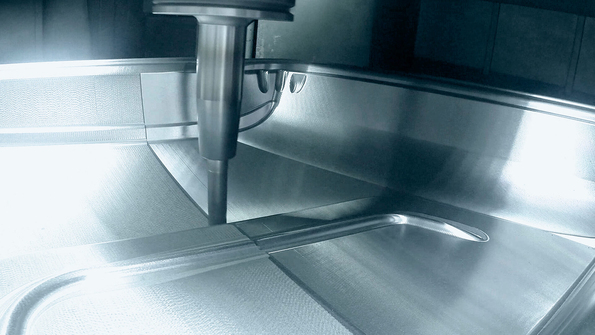
The challenge: Part surface quality needs to be improved. Those responsible in the Volkswagen manufacturing plant in Wolfsburg search for a suitable CAD/CAM application.
Solution: Tebis, a provider of software technology located in southern Germany, which has just taken over a leading role in the market for CAM solutions, offers exactly what Wolfsburg is looking for. The high degree of surface quality that can be achieved with Tebis as well as the possibility of dividing up milling areas in a standard way and linking each to optimal strategies and machining tools are convincing – as of now, NC programming at Group headquarters will only be done using Tebis.
Results: Horst Spanner, Strategic Account Manager at Tebis, has provided support for Volkswagen from the very beginning to the present day. He recalls: "Both decision makers and Tebis users were thrilled with the outstanding surface quality. And an incredible amount could be accomplished in NC programming with Tebis that previously had to be done on the control."
2000: Focus on manufacturing processes
standardization and 2.5D process
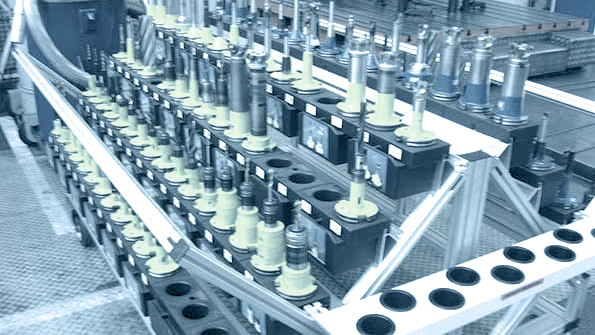
The challenge: Die manufacturing is growing so quickly that the structures cannot keep up – programming and manufacturing are too slow, tool costs are too high and machines are idle for too long. No one really knows which of the many tools are actually in use and when they have to be switched on the machine.
Solution: Tebis steps in not only as a software provider but also as a service provider. Tebis and Volkswagen jointly analyze all manufacturing processes and derive specific measures from the results: The tools are registered, standardized and stored in Tebis process libraries. A template-based process forms the basis for automated 2.5D manufacturing. At the same time, Tebis simulation methods come into use – these enable exact planning of the machining operation in advance, including tilt angles and suitable tools, and checking for collisions with all components of the milling machine after NC programming. The use of multiple setups is also integrated.
Results: Standards, templates and process libraries provide for significantly more efficient manufacturing. The experts’ knowledge is transparent and accessible to everyone in the virtual system.
2008: Digital solutions
small parts process
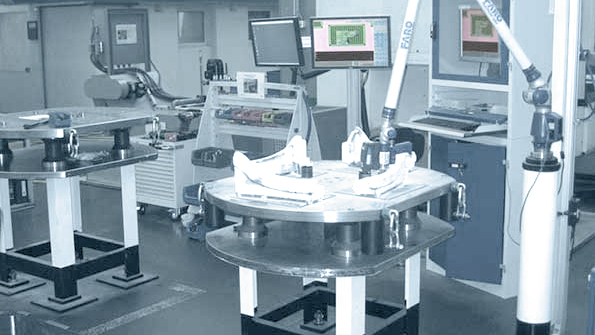
The challenge: In 2008, the die manufacturers at the Wolfsburg location produce up to 8000 small parts annually, of which about 80% are cast. Multiple setup enables the setup of up to eight trim and coining steels on a grid plate. But how can small parts be machined without collisions and casting allowances be reliably determined?
Solution: Tighter intermeshing of upstream CAD/CAM processes. The entire clamping situation, including the grid plate and cast blanks, is digitized and represented in the virtual world. It can thus be clearly understood by the machine operator at all times using Tebis Viewer systems. Standardized templates also simplify NC programming.
Results: Small parts can now be manufactured significantly faster and more reliably. Roland Schöbel, head of machining in the Wolfsburg die manufacturing operation, explains this very clearly with the example of small parts manufacturing on a DMU 125 P at the 2010 Tebis Open House. "On June 1, 2009, the fraction of uptime on this machine was still 60%. Approximately 25% of faults could be attributed to CNC errors. The result was completely different on October 5 that same year: Uptimes were about 90% and CNC faults went down to zero." (1)
(1) Presentation "From programming to the finished trim steel," Roland Schöbel, head of machining, Wolfsburg die manufacturing, Volkswagen AG. Tebis 2010 Open House, Martinsried/ Planegg, Germany
2009: More than just CAM
Reverse engineering
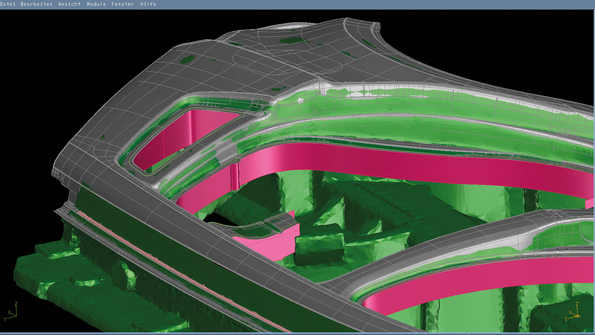
The challenge: From now on the focus is on change processes: Part data are corrected and actual dies are remilled – not just by those in Wolfsburg, but also by the participating locations and suppliers. Some CAD data are either outdated or no longer available.
Solution: Actual dies are to be digitized and quickly and accurately transferred to the virtual world using reverse engineering software. After a benchmark test, Tebis is selected as the best reverse engineering system in die manufacturing. The "Digitization and reverse engineering" team is especially established in the organization for this task.
Results: 2011 the new process enables exactly the same dies to be quickly and efficiently fabricated and tried out for multiple locations at the same time. "Our die manufacturers worldwide have benefited from this – This even enabled us to very quickly produce the dies for Mexico in a standardized process," says Roland Schöbel. Wolfsburg becomes the "center of reverse engineering."
2011: Morphing
Higher-level process organization
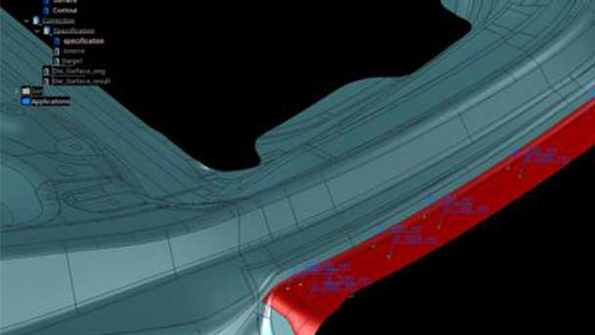
The challenge: Suitable software tools are needed to compensate sheet metal springback.2011 Time-consuming repairs in tryout and coordination issues result in enormous delays.
Solution: Even complex surface models can be automatically morphed in Tebis based on various morphing rules. The high dimensional accuracy ensures that morphed and trimmed dies fit together seamlessly. The decision is clear for Roland Schöbel after the 2011 Tebis Open House: The Tebis morphing solution will help to reduce correction grinding and design costs. In parallel, the responsibility for production of the correction data – just like reverse engineering and digitization – will lie with the "CAD with Tebis" team in the future.
Results: Florian Schulze, head of the competency center for milling data, summarizes the results of these changes at the 2012 Tebis Open House for an enthusiastic audience: "Our new department structure as well as the Tebis solution for morphing and the Tebis analysis and optimization functions enabled us to get correction grinding under control. We scored in all areas: Parts got to the machine faster, CAD data and NC programs could be updated faster and surface quality was even better." (2)
(2) Presentation "Faster readiness for series production through correction grinding close to production in die manufacturing," Florian Schulze, head of the competency center for milling data, Volkswagen AG.Tebis 2012 Open House, Martinsried/ Planegg, Germany.
2013: Active surface design
Putting together what belongs together
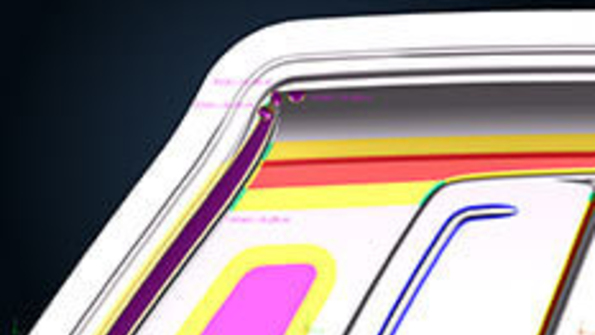
The challenge: Active surface design holds further potential for optimization. Manual reworking in tryout is still taking too long, while ultra-modern high-feed cutters (HFC) yield the best results on exact surfaces. Active surface design is therefore completely reframed with Tebis Implementation.
Solution: Instead of defining virtual wall thickness allowances, Tebis can be used to directly incorporate offsets, radius relief and pressure and spotting surfaces in the CAD model, resulting in significantly simplified active service data. From now on, active surfaces are designed exclusively using Tebis. This task is addressed by a new department, the "competency center for milling data," assigned not to design but to manufacturing instead. In order to fully benefit from the advantages of high-feed cutters, Tebis also brings a special solution to the market where the contour of the virtual tool exactly corresponds to the contour of the tool actually used. Material contact is thus precisely defined.
Results: The use of predesigned active surfaces significantly accelerated NC programming and reduced manual reworking in tryout to a minimum. Corrections on the die can be quickly implemented in NC programming. "Even if just one pressure area was overlooked in the process, the correction cost us up to 10,000 Euros. Today, for example, we install dies for doors that we previously had to rework directly in the press for roughly 160 hours," says Schöbel. The precise contact geometry, in conjunction with the high surface quality, also saves up to 50% of the machining time with the high-performance high-speed cutters on roughing, re-roughing and pre-finishing.
2015: Tebisand ProLeiS
... completely harmonized
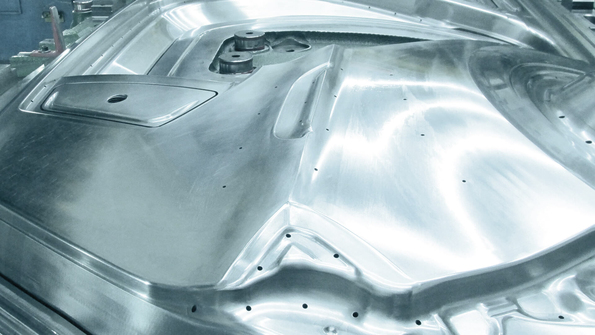
The challenge: Even though Volkswagen has already had very good results using the ProLeiS MES solution, an end-to-end process must be established, combining the new structures and the close interaction of the CAD and CAM, with which all processes can be planned and all data and modifications can be managed, checked and controlled, from the first active surface to manufacturing, independent 2015of location.
Solution: This objective was achieved in 2015: All work steps are completely represented in the virtual world of Tebis and Proleis. Both systems are perfectly harmonized. This enables the implementation of dynamic and flexible manufacturing planning, including complete data management.
Results: “We can now automatically disassemble over 100 manufactured die parts and work directly with the active surface data,” Schöbel summarizes. "If we have to correct dies, all areas affected by these changes are specifically blocked for machining – everything else continues to run smoothly. What we have established here really is a network in the sense of Industry 4.0."
Outlook
New developments are successively integrated in the existing overall process: A further process analysis from August to December 2017 indicated how we can prepare small parts and have them programmed even faster and with a higher degree of automation. Corresponding measures are planned. A key advantage for manufacturing preparation is also the extended design technology with which surfaces and solids can be designed parametrically and associatively: The entire part is updated automatically in the event of subsequent modifications. This enables geometric changes to be integrated more quickly, easily and flexibly. Tebis will offer this technology as of Version 4.1.


